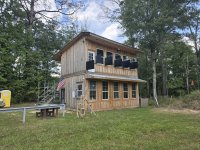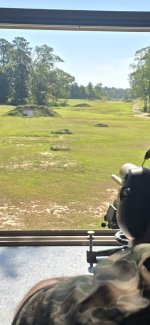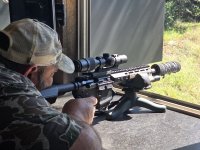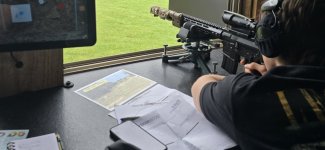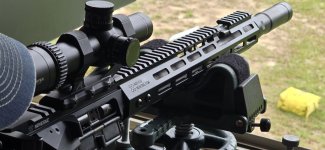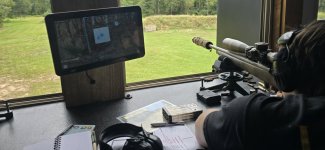I’ve attended many classes at Thunder Ranch, Shootrite, Rangemaster, Yavapai with Louis Awerbuck, Tactical Response, private classes with my sons, done stints in USPSA, High Power, and Three Gun – I've been on a lot of ranges. It occurred to me that pound for pound, hour for hour, my first trip to Roaming Shot was one of my best range trips ever.
I met an expert. Ben Fabre provides a facility and understanding designed to demonstrate the potential of the shooter and equipment. Roaming Shot Range in Slaughter, LA has a 1000 yard capability. I scheduled a morning with Ben because I have two rifles I enjoy and two rifles I’ve been fighting. I’m lucky to be a member of Palo Alto Rifle and Pistol Club, which has multiple ranges allowing for rifle shooting out to 600 yards. I hoped to see what I could do with a 20” Grendel beyond the 600 yard line and to see what a short barrel Grendel was capable of. I also have a freshly scoped custom 700 and AR-10, both in 308. I was struggling to get the 700 to group to the capability of the Krieger barrel and the AR-10 to work at all with a suppressor attached.
When you arrive at Roaming Shot, you walk up stairs to an air conditioned second story room with several windows you can shoot from. There are screens mounted next to you to show hits on the steel targets out to 1000 yards. A work bench has a plethora of tools behind the shooters and there is a drink/snack station to the side. We got started with the 20” Noveske barreled Grendel. Ben asked to shoot the gun to see what it was doing and put a few rounds down range to feel her out. After getting the velocity from a Garmin Xero and running a ballistic calculator, I got behind the glass and get direction to shoot the steel deer at 300, square metal at 400, bear at 540, pink bullseye at 700 – Ben is calling how many minutes to dial in, and I’m getting hits. At 800 I’m thrilled. I believed I had a legitimate 800+ yard gun but I hadn’t proved it – then I got three hits at 900. “Go to the buffalo at 1000. Give me another 5 minutes.” I turned the scope elevation up – and hit a wall. I only had another two minutes to give. Murphy laughs – I don’t have the scope in a base with any built in elevation. I’ve never had a better excuse to get a new mount. For the record, the barrel likes Hornady 123 Gr SST and does nothing but produce sub MOA groups.
The second rifle was also a 6.5 Grendel, but with a 12.5” Noveske barrel. Hornady has recently released a 100gr V-Match ELD-VT and the scuttlebutt on the interwebs is that it performs in general and out of short barrels specifically. This was my first outing of consequence with the 100 gr, so Ben zero’d the gun. His final group at 100 was less than half an inch – Hornady and Noveske are doing it right. Ben got back behind the spotting scope and walked me out. With an old US Optics SR6 1.5-6 scope, I got 3/3 hits at 600. For the record, that 100 gr bullet at the muzzle is making 2,450-2,475 FPS for about 1,350 ft/lbs of energy. Call me old fashioned, but I think the short 6.5 Grendels are the sweet spot for a light gun that can deliver enough power for deer and hogs at the distances most people actually shoot.
We moved on to the Remington 700. I’d told Ben about my concerns and the first thing he did was check the torque on every fastener and bolt on the gun. He used a digital in/lb driver. I was surprised to hear his call outs – “That isn’t even 13 in/lbs, this is only 25 ft lbs, that's over 60 in/lbs” etc – I laughed and give credit to Death Before Dismount who recently disparaged inexpensive analog manual adjustment in/lb drivers, which I had used. It may, as it turns out, be worth investing in a quality digital in/lb driver if you’re playing the precision rifle game. My second credit to Death Before Dismount is he donated a 50% off US Optics certificate to my cause which I used to purchase a FDN-17X. The scope is excellent thus far. Ben mentioned he’d prefer more positive clicks, but other than that he had nothing but praise. The glass is super clear and it seems to be a very well built scope. I’m out to wear out the barrel in an effort to learn the capability of the 18” 308 in conjunction with that scope.
One of the most important things I learned was that the parallax markings on scopes are, at best, a rough guide. In the past, I've just dialed to the distance marked. Ben explained the specific magnification being used, shooters eye and so forth meant it is to be determined by actually moving your head to see if the reticle “floats” and if you can’t move around a little without the reticle adjusting, the parallax isn’t right. I found this particularly interesting because I initially complained the US Optics specifically only has one marking for 100 yards; other than that, it is just a smaller to larger rheostat laser engraving. That turns out to be the right way to do it.
Ben went on to prove to me that the 700 was shooting, and that I hadn’t set my scope up properly for my eye. It needed to come back more than half an inch, but he adjusted the rings in moments and gave me a few pointers about how I was manipulating the rifle and magically I was stacking rounds. Ben shot a group that was less than an inch and a half at 300 yards. After a sub MOA group of my own, we moved on to my nemesis.
Years ago I built an AR-10. I thought I had the ideal parts and configuration. I spec’d everything and it was a laser beam unsuppressed and a jam-o-matic with a can up front. For years I toyed with mags, ammo, springs, adjustable gas blocks, buffers etc. Ultimately, I've switched to a Noveske 16” barrel with a switch block, KAK bolt with dual ejectors and a 9.5 oz KAK buffer – she runs like a top with a Sandman K up front. The gun is shooting less than an inch and flinging brass out 20 feet at three o’clock. I’m not sure if Roaming Shot brings good luck or I finally threw enough money and parts at a problem to find success, but that rifle ran 100% and demonstrated it may be possible for a suppressed AR-10 to run even if it isn’t a $5000+ factory rifle.
Going 4 for 4 makes for a great day – zero malfunctions and the arrows were flew straight and far. Turns out the Indian needed a little work and the set ups got some tweaking, but Ben had both under control. I can’t recommend the experience enough. His minor corrections – put that thumb over here, pay more attention to your level, try pulling the butt of the rifle more toward your center – all tightened me up.
If you’re anywhere near Slaughter, LA and you consider yourself an enthusiast with anything that resembles a capable rifle – you owe yourself a trip. After a couple hours, you’ll know what you and your equipment can actually do in tandem and if you have any areas that are correctable – either physically or mechanically – chances are Ben will fix it in real time. Check them out at https://www.roamingshot.com/.
I met an expert. Ben Fabre provides a facility and understanding designed to demonstrate the potential of the shooter and equipment. Roaming Shot Range in Slaughter, LA has a 1000 yard capability. I scheduled a morning with Ben because I have two rifles I enjoy and two rifles I’ve been fighting. I’m lucky to be a member of Palo Alto Rifle and Pistol Club, which has multiple ranges allowing for rifle shooting out to 600 yards. I hoped to see what I could do with a 20” Grendel beyond the 600 yard line and to see what a short barrel Grendel was capable of. I also have a freshly scoped custom 700 and AR-10, both in 308. I was struggling to get the 700 to group to the capability of the Krieger barrel and the AR-10 to work at all with a suppressor attached.
When you arrive at Roaming Shot, you walk up stairs to an air conditioned second story room with several windows you can shoot from. There are screens mounted next to you to show hits on the steel targets out to 1000 yards. A work bench has a plethora of tools behind the shooters and there is a drink/snack station to the side. We got started with the 20” Noveske barreled Grendel. Ben asked to shoot the gun to see what it was doing and put a few rounds down range to feel her out. After getting the velocity from a Garmin Xero and running a ballistic calculator, I got behind the glass and get direction to shoot the steel deer at 300, square metal at 400, bear at 540, pink bullseye at 700 – Ben is calling how many minutes to dial in, and I’m getting hits. At 800 I’m thrilled. I believed I had a legitimate 800+ yard gun but I hadn’t proved it – then I got three hits at 900. “Go to the buffalo at 1000. Give me another 5 minutes.” I turned the scope elevation up – and hit a wall. I only had another two minutes to give. Murphy laughs – I don’t have the scope in a base with any built in elevation. I’ve never had a better excuse to get a new mount. For the record, the barrel likes Hornady 123 Gr SST and does nothing but produce sub MOA groups.
The second rifle was also a 6.5 Grendel, but with a 12.5” Noveske barrel. Hornady has recently released a 100gr V-Match ELD-VT and the scuttlebutt on the interwebs is that it performs in general and out of short barrels specifically. This was my first outing of consequence with the 100 gr, so Ben zero’d the gun. His final group at 100 was less than half an inch – Hornady and Noveske are doing it right. Ben got back behind the spotting scope and walked me out. With an old US Optics SR6 1.5-6 scope, I got 3/3 hits at 600. For the record, that 100 gr bullet at the muzzle is making 2,450-2,475 FPS for about 1,350 ft/lbs of energy. Call me old fashioned, but I think the short 6.5 Grendels are the sweet spot for a light gun that can deliver enough power for deer and hogs at the distances most people actually shoot.
We moved on to the Remington 700. I’d told Ben about my concerns and the first thing he did was check the torque on every fastener and bolt on the gun. He used a digital in/lb driver. I was surprised to hear his call outs – “That isn’t even 13 in/lbs, this is only 25 ft lbs, that's over 60 in/lbs” etc – I laughed and give credit to Death Before Dismount who recently disparaged inexpensive analog manual adjustment in/lb drivers, which I had used. It may, as it turns out, be worth investing in a quality digital in/lb driver if you’re playing the precision rifle game. My second credit to Death Before Dismount is he donated a 50% off US Optics certificate to my cause which I used to purchase a FDN-17X. The scope is excellent thus far. Ben mentioned he’d prefer more positive clicks, but other than that he had nothing but praise. The glass is super clear and it seems to be a very well built scope. I’m out to wear out the barrel in an effort to learn the capability of the 18” 308 in conjunction with that scope.
One of the most important things I learned was that the parallax markings on scopes are, at best, a rough guide. In the past, I've just dialed to the distance marked. Ben explained the specific magnification being used, shooters eye and so forth meant it is to be determined by actually moving your head to see if the reticle “floats” and if you can’t move around a little without the reticle adjusting, the parallax isn’t right. I found this particularly interesting because I initially complained the US Optics specifically only has one marking for 100 yards; other than that, it is just a smaller to larger rheostat laser engraving. That turns out to be the right way to do it.
Ben went on to prove to me that the 700 was shooting, and that I hadn’t set my scope up properly for my eye. It needed to come back more than half an inch, but he adjusted the rings in moments and gave me a few pointers about how I was manipulating the rifle and magically I was stacking rounds. Ben shot a group that was less than an inch and a half at 300 yards. After a sub MOA group of my own, we moved on to my nemesis.
Years ago I built an AR-10. I thought I had the ideal parts and configuration. I spec’d everything and it was a laser beam unsuppressed and a jam-o-matic with a can up front. For years I toyed with mags, ammo, springs, adjustable gas blocks, buffers etc. Ultimately, I've switched to a Noveske 16” barrel with a switch block, KAK bolt with dual ejectors and a 9.5 oz KAK buffer – she runs like a top with a Sandman K up front. The gun is shooting less than an inch and flinging brass out 20 feet at three o’clock. I’m not sure if Roaming Shot brings good luck or I finally threw enough money and parts at a problem to find success, but that rifle ran 100% and demonstrated it may be possible for a suppressed AR-10 to run even if it isn’t a $5000+ factory rifle.
Going 4 for 4 makes for a great day – zero malfunctions and the arrows were flew straight and far. Turns out the Indian needed a little work and the set ups got some tweaking, but Ben had both under control. I can’t recommend the experience enough. His minor corrections – put that thumb over here, pay more attention to your level, try pulling the butt of the rifle more toward your center – all tightened me up.
If you’re anywhere near Slaughter, LA and you consider yourself an enthusiast with anything that resembles a capable rifle – you owe yourself a trip. After a couple hours, you’ll know what you and your equipment can actually do in tandem and if you have any areas that are correctable – either physically or mechanically – chances are Ben will fix it in real time. Check them out at https://www.roamingshot.com/.
Attachments
Last edited:


